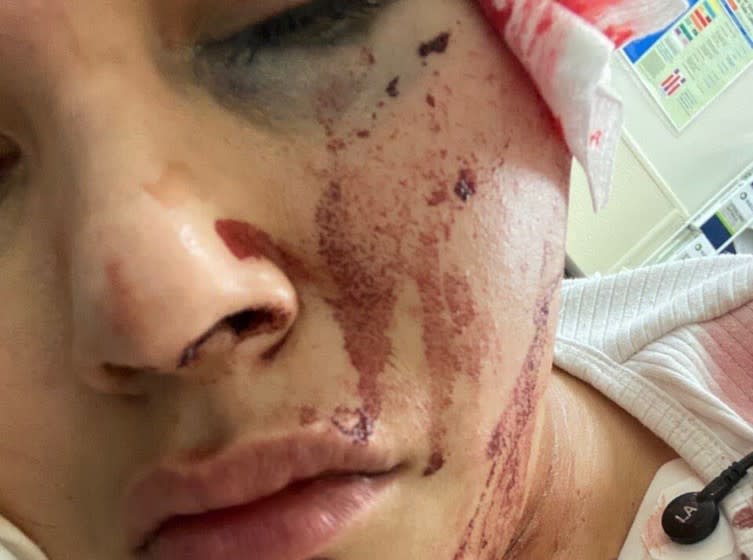Woman driving near protests says LAPD foam round injured her, files $10-million claim

A woman who was at a Los Angeles intersection near a protest over the killing of George Floyd filed a legal claim Monday, alleging she was struck in the head by a foam bullet fired by Los Angeles police, leaving her with stitches, a fractured cheekbone and a brain injury.
Jasmine Morales, 26, spent nine days hospitalized at Cedars-Sinai Medical Center and is seeking $10 million from the city of Los Angeles for injuries she suffered during the May 30 incident, according to the claim.
The projectile, likely a 40-millimeter hard foam round, flew in through her open driver's side window near the Grove about 8 p.m. as she was driving to a Target store, according to the legal filing and her lawyers.
The impact nearly knocked Morales unconscious, according to her claim. Neama Rahmani, one of her lawyers, said that based on eyewitness accounts, the officer had fired the projectile from inside a police car.
Morales’ attorney said she was traveling through the area and was not a part of the protests.
"For an officer in a black-and-white to shoot a nearby driver in the face is not tactical police work so much as a drive-by shooting," Rahmani, a former federal prosecutor, said. The claim, the required legal precursor to a lawsuit, alleges the LAPD officer clearly violated department guidelines for using such force.
“It was willful officer misconduct,” Rahmani said. “The officer took deliberate aim and fired while she was driving her car. There’s no defense for that brutality.”
Josh Rubenstein, communication director for the Los Angeles Police Department, said the department was “not previously aware of this incident” and is now looking into the claim’s statements.
Photographs Morales’ attorneys said were taken in the aftermath show the left side of Morales' face bloody and bruised with a wound on her temple and a black eye.
Morales remembers little of the incident apart from waking up in Cedars-Sinai, according to her attorneys. Her passenger drove her the few blocks to the hospital, where her attorneys said she needed critical care.
Morales, according to the claim, never heard any warning or order from the officers, and protesters were not around her Toyota but were nearby. The incident unfolded as a protest in the Fairfax district escalated into violence, with officers using batons and firing hard foam rounds into the crowd, some of whom set fire to parked police cars.
Morales required 20 stitches, and the Los Angeles resident suffered a fractured cheekbone, traumatic brain injury, bruising and impaired vision, the legal claim said. Morales was released from the hospital June 8, according to Rahmani.
"In brain injury cases, she could get better in a matter of weeks or suffer lifelong impacts," Rahmani said.
Houman Sayaghi, another of Morales' attorneys, said the foam projectile did not fall into the car after it struck his client, but he hopes video footage from surrounding security cameras, including a nearby bank, will help reconstruct events.
During the protests May 30, Los Angeles police deployed a “40-millimeter Less-Lethal Launcher” using single-shot hard foam projectiles. It is a device the LAPD and other police agencies claim allows for more precise targeting of violent suspects, thereby reducing the risk of serious injuries caused by other “less-lethal” alternatives.
But Rahmani said that an officer firing the weapon at a motorist is clearly an indiscriminate use of force against a person who posed absolutely no threat and was nothing but an innocent bystander passing through the area.
The civilian Los Angeles Police Commission and its inspector general’s office have said they will review all complaints of excessive force against the department.
An LAPD spokeswoman previously said the department is reviewing use of the 40-millimeter launcher and plans to release the findings “at a later time.”
In the wake of multiple accusations of indiscriminate fire by officers, Los Angeles Mayor Eric Garcetti said he had directed the LAPD to “minimize” use of the less-lethal weapons when dealing with peaceful protesters.
A Times review of dozens of instances of police force during protests over the police killing of Floyd found that demonstrators suffered a range of injuries at the hands of the LAPD, including minor bruising from baton strikes and falls as police skirmish lines advanced, and serious injuries to some protesters' genitals and heads from foam and sponge bullets and beanbags being launched into crowds, sometimes from close range.
A 2017 analysis of 1,984 people struck by rubber or plastic bullets found that 3% were killed and 15% permanently injured. The peer-reviewed study, published in the journal BMJ Open, reviewed 30 years of scientific papers worldwide on injuries from kinetic impact projectiles, or KIPs, which include rubber-coated bullets, beanbag rounds, sponge rounds and others.
Dr. Rohini Haar, the study’s lead author and an emergency room physician, told The Times that the so-called sponge rounds fired by the 40-millimeter launcher had not reduced problems.

